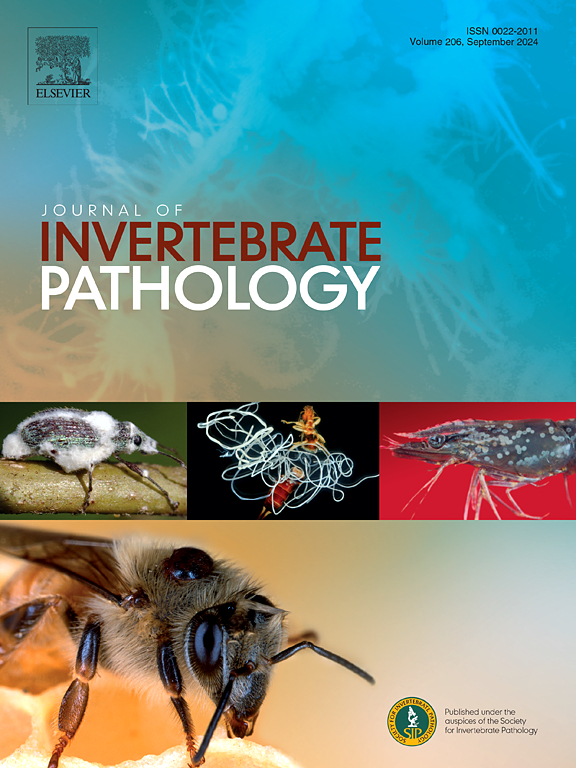The use of gut bacteria isolated from Thai honey bees (Apis spp.) to control Nosema ceranae infection in the giant honey bee, Apis dorsata
IF 2.4
3区 生物学
Q1 ZOOLOGY
引用次数: 0
Abstract
Honey bee (Apis spp.) health is threatened by various pests and pathogens, including the microsporidia, Nosema ceranae. We investigated using two groups of beneficial gut bacteria isolated from Thai honey bees, Apilactobacillus kunkeei and Bifidobacterium sp., as a potential strategy to mitigate N. ceranae infections in the giant honey bee, Apis dorsata. For 24 h, newly emerged workers were individually fed 2 µL of a 50 % sucrose solution containing 2 × 105 colony-forming units (CFU) of gut bacteria isolated from A. cerana, A. dorsata, A. florea, and A. mellifera workers. The bees were maintained in an incubator at 34 ± 2 °C and 55 ± 5 % RH. Subsequently, they were group-fed, 50 bees/group, with 500 μL of 50 % sucrose solution containing 107N. ceranae spores. Bees fed A. kunkeei and Bifidobacterium sp. had significantly reduced mortality, N. ceranae infectivity, infection rate, and infection ratio compared to bees not fed the beneficial gut bacteria. Consumption of gut bacteria isolated from all four Thai honey bee species significantly increased the protein content of the hypopharyngeal glands of A. dorsata workers over that of bees not fed the bacteria. Collectively, these findings suggest that beneficial gut bacteria may serve as a promising strategy for protecting honey bee colonies from Nosema disease.

利用从泰国蜜蜂(Apis spp.)中分离的肠道细菌控制巨型蜜蜂(Apis dorsata .)的微孢子虫感染
蜜蜂的健康受到各种害虫和病原体的威胁,包括微孢子虫、小孢子虫。我们研究了从泰国蜜蜂中分离的两组有益肠道细菌,kunkeei芽胞杆菌和双歧杆菌,作为减轻巨型蜜蜂蜜蜂中N. ceranae感染的潜在策略。新出的工蜂分别喂食2µL含有2 × 105个集落形成单位(CFU)的50%蔗糖溶液,该溶液中含有从蜜蜂工蜂、dorsata工蜂、a . florea工蜂和a . mellifera工蜂中分离的肠道细菌。将蜜蜂置于培养箱中,温度为34±2°C,相对湿度为55±5%。然后用含107N的50%蔗糖溶液500 μL分组饲喂,每组50只。ceranae孢子。与未饲喂有益肠道细菌的蜜蜂相比,饲喂昆蜂和双歧杆菌显著降低了蜜蜂的死亡率、蜜蜂的感染性、感染率和感染率。食用从所有四种泰国蜜蜂中分离出的肠道细菌显著增加了A. dorsata工蜂下咽腺的蛋白质含量,而不是喂食细菌的蜜蜂。总的来说,这些发现表明有益的肠道细菌可能是保护蜜蜂群体免受小虫病侵害的一种有希望的策略。
本文章由计算机程序翻译,如有差异,请以英文原文为准。
求助全文
约1分钟内获得全文
求助全文
来源期刊
CiteScore
6.10
自引率
5.90%
发文量
94
审稿时长
1 months
期刊介绍:
The Journal of Invertebrate Pathology presents original research articles and notes on the induction and pathogenesis of diseases of invertebrates, including the suppression of diseases in beneficial species, and the use of diseases in controlling undesirable species. In addition, the journal publishes the results of physiological, morphological, genetic, immunological and ecological studies as related to the etiologic agents of diseases of invertebrates.
The Journal of Invertebrate Pathology is the adopted journal of the Society for Invertebrate Pathology, and is available to SIP members at a special reduced price.

 求助内容:
求助内容: 应助结果提醒方式:
应助结果提醒方式:


